The older I get, the more I see how good ideas undergo distortion as schools seek to implement them. Collecting achievement data morphs into half termly data drops, an Ofsted focus on curriculum distorts into swirly whirly tube maps, intent statements and thinking this means learners – rather than staff – being able to explain curriculum progression, ‘fidelity to the programme’ in phonics mutates into people thinking they cannot deviate from any aspect of any programme at all (when it’s about not mixing and matching the sequence of phoneme:grapheme correspondences), dual coding gets reduced to putting icons on everything, retrieval practice limited to start of lesson quizzing, giving pupil feedback mutated into crazy triple marking rituals and so on and so on. The concept of differentiation has undergone such far-reaching distortion and has spawned such unhelpful practices that it has been replaced by adaptive teaching . Entirely predictably, adaptive teaching itself is already beginning to experience lethal mutation.
Differentiation was originally intended as a process of planning teaching in order to meet a range of learning needs. Sadly, the concept followed a well-worn path – what was once a good idea gave rise to counter-productive practices. These distortions of the original good idea set a ceiling on achievement for some learners[1] who were always given easier work whilst simultaneously massively increasing workload for teachers who had to plan multiple different activities. However, the original challenge of meeting a range of learning needs remains.
Enter adaptive teaching, the new solution to an old problem. Whereas traditional differentiation focused on individual learners or small groups of learners, adaptive teaching focuses on the whole class. Instead of providing different activities for different learners, adaptive teaching advocates teaching the same lesson to all, by providing scaffoldsto those who need additional initial support in order to access the same ambitious curriculum and meet the same high expectations. Crucially, additional support offered through scaffolding should be reduced over timeso that all learners can become increasingly independent.
‘Provide scaffolds’ is doing a lot of work here. If an adaptive teaching approach is to really help teachers meet the range of learning needs, it needs a lot more unpacking. How does it do this and what are the limits of this approach? We need to avoid the magical thinking that sees it as a way of teaching that can always and everywhere meet every need, no matter what. Adaptive teaching is not a miracle cure. There will always be a very small minority of learners whose learning needs are very, very different and for whom all the scaffolding in the world won’t be enough. And there may also be one or two in a school every so often who find learning really easy and for whom extension activities alone are not going to be sufficient. As adaptive teaching becomes the new orthodoxy, we must be alert to moves to proclaim as heresy any suggestion that for a specific learner, adaptive teaching alone might not be the most appropriate response.
The big difference between adaptive teaching and differentiation is that with differentiation, it was expected that a large minority of your class were not able to access the same work as the majority, so needed something notably different. Indeed, it was often expected to group your class into ability groups, each getting a different activity, something like this:
| SEND group Very easy activity | Lower group Easier activity | Middles Core activity | Top middles Quite hard activity | Top group Very hard activity |
With an adaptive teaching approach, by contrast, being given different work becomes rare rather than routine. Adopting adaptive teaching as the main way of meeting a range of learning needs does not mean that no learner can ever be given a different task or learning objective from other learners. In a very small minority of classes, there may be an individual whose additional learning needs cannot be met through adaptive teaching alone. There is also a difference between what is achievable in cumulative subjects like history and hierarchical subjects like maths.
Adaptive teaching, properly understood, helps teachers address a range of learning needs without lowering expectations or generating massive workload. It’s an ‘upstream’ approach, that reduces rather than abolishes the need for ‘downstream’ ‘additional and different interventions.[2] Quality first teaching may have been a clunky phrase, but the word ‘first’ is quite right. First of all, let’s teach everyone as effectively as we possibly can. Then, and only then, if we are sure we’ve really done that, do we then look to what else might be necessary on top of quality teaching, for a small minority of learners. But unless we unpack what terms like adaptive teaching and scaffolding really involve, they will just become pious words uttered performatively and judgementally.
In what follows, I explore the role of adaptive teaching in supporting cognitive additional learning needs. Adaptive teaching also has a role in supporting other needs such as physical, communication and SEMH needs – but that’s not my focus in this piece.
Adaptive teaching: adapting memory demands
In an adaptive learning approach, learners have same learning objectives and do same tasks, but level of challenge can be increased or decreased according to need (including adaptions made in real time in the light of in the moment feedback gathered in lessons). To unpack what this actually involves, I’ m going to start by using the work of Adam Boxer on what it means for work to be more or less challenging. You can read about it here, and also in more detail in his brilliant book Teaching Secondary Science, a book that is well worth reading even if you don’t teach science or secondary. Adam’s examples are – obviously – all drawn from science but here I am going to use the same approach to examine what are the factors underpinning whether something is more or less challenging. Adam outlines four factors that determine cognitive challenge, which, in a similar fashion to Adam’s work, we will explore one by one.
Factor one
For each example, which is the more challenging?
Example 1.
- Why did the Fire of London spread so easily?
Or
- Give two reasons why the Fire of London spread so easily?
Example 2.
- What are the typical features of a mammal and the typical features of a reptile?
Or
- What are the typical features of a mammal?
Example 3.
- Learning to read a clock using the minute hand and the hour hand
Or
- Learning to read a clock using just the hour hand
Example 4.
- Measuring the length of a curved road using paper on an Ordnance survey map
Or
- Measuring the length of a curved road using paper on a simplified map featuring only roads.
Answers:
Example 1.
- is more challenging because it is more open ended so as well as thinking of the answers, you also have to think if there are any more answers.
- is less challenging because it tells you how many answers to give so that is one less thing to think about
Example 2
- is more challenging because it asks you to think about the typical features of both a mammal and a reptile
- is obviously less challenging because it only asks you to think about the features of a mammal
Example 3:
- is more challenging because you have to think about both the hour hand and the minute hand
- is less challenging because you have to think about only the hour hand
Example 4:
- is more challenging because the Ordnance Survey maps contain a lot of visual information, much of which requires screening out in order to concentrate on the road
- is less challenging because the amount of visual information has been reduced, so it is easier to concentrate on measuring individual roads
The first factor that determines challenge is therefore:
The greater the number of things to think about, the more challenging the task
This was the factor that was usually changed in traditional differentiation. Some learners were asked to think about fewer things than others.
Factor two
For each example, which is the more challenging?
Example 1:
- explaining why day and night happen
or
- explaining why the seasons happen
Example 2:
- add together two [positive] numbers
or
- add together two negative numbers
Example 3:
- give two reasons why the Fire of London spread so easily
or
- give two reasons why the Protestant Reformation spread so easily
Example 4:
- Write three sentences which tell the reader about Lady Macbeth
or
- Write three sentences which tell the reader about Red Riding Hood
Answers:
Example 1:
- is less challenging than b) because it is less complicated. You can model day and night fairly easily with a couple of balls and a torch. The reasons why we have seasons is much more complicated and difficult to model.
Example 2:
- is less challenging than b) because positive numbers are more familiar and more easily represented through concrete resources than negative numbers
Example 3:
- is less challenging than b) because the causes are easily relatable to everyday experience (dry weather, flammable materials, houses close together, no fire brigade) than the complicated and contested factors that led to the Protestant Reformation. Here factors are far removed from our experience.
Example 4:
- is less challenging than a) because the motives of Red Riding Hood (visiting a grandma, disobeying your parents) are more immediately relatable than the motives of Lady Macbeth (wanting power and control mediated through her relationship to her husband in a patriarchal society).
The second factor that determines challenge is therefore:
Some content is inherently more demanding than other content (usually because its more abstract)
Factor three:
For each example, which is the more challenging?
Example 1:
- 2+3=
- 4+1=
- 5+0=
- 1+4=
Or
b)
- 2+3=
- 4+1=
- 5+0=
- 1+?=5
Example 2:
- Why did the Fire of London spread so easily?
or
- Why did the Fire of London spread so easily?
- flammable
- close together
- fire brigade
- weather
Example 3:
- What are the typical features of a mammal and the typical features of a reptile?
or
- What are the typical features of a mammal and the typical features of a reptile?
| mammal | reptile | |
| skin | ||
| breathing | ||
| reproduction | ||
| heat |
Example 4:
- Write three sentences which tell the reader about Red Riding Hood
- RRH wore…
- Her grandmother needed food so …
- Because of the dangerous wolf, …
or
- Write three sentences which tell the reader about Red Riding Hood
- RRH wore…
- She carried …
- Her mother warned her …
Answers
Example 1:
- is more challenging than a) because we’ve removed the predictable pattern
Example 2:
- is less challenging than a) because we have provided a word bank
Example 3:
- is less challenging than a) because we have provided a graphic organiser
Example 4:
- is more challenging than b) because the writing frame involves complex sentences
The third factor that determines challenge is therefore:
Challenge can be altered by providing or removing external support for memory demands
Factor four:
Which is the more challenging?
- What are the typical features of a mammal and the typical features of a reptile?
- Learners asked to answer question immediately after teacher has explained the differences
or
- What are the typical features of a mammal and the typical features of a reptile?
- Learners are asked to answer this question 6 weeks after teacher has explained the differences
Answer: clearly a) is less challenging than b)
Which brings us to the fourth and final challenge factor
Challenge is determined by the things a learner knows
- If a child knows the information better, then the same question on the same stuff will be less challenging
- If a child does not know the information as well, then the same question on the same stuff will be more challenging
The four challenge variables are therefore:
- Having to think about more things
- The intrinsic demands of the content
- How much external support for memory demands is provided
- How much the learner knows
We can therefore use this to adapt what we teach, decreasing or increasing the challenge by:
- Adapting the number of things learners have to think about
- Planning a curriculum that reinforces and builds on previous knowledge: connecting new learning to previously learned content and preparing for and improving access to future learning
- Providing support for memory demands
- Ensure learners know enough to access the lessons AND have a robust culture of retrieval so knowledge is remembered long term
We know that working memory is small and easily overwhelmed. When working memory is overloaded, information isn’t transferred to long term memory: learning fails to take root. For learners with cognitive additional learning needs, working memory is likely to be even smaller. Some fortunate learners will have sufficient prior knowledge to compensate for teaching that underestimates the memory demands of the task in hand. They therefore have more resilience to such sub-optimal teaching. However, even cognitively privileged learners are likely to benefit from learning that has been planned with memory demands in mind. Such an approach is useful for all and vital for some.
This is the shift. Because some privilege learners succeed despite teaching approaches that are likely to overwhelm working memory, the all too human temptation is to see the problem with some learners not being successful as lying within those learners rather than the result of our teaching. Ruth Ashbee’s excellent blog makes this point well. She imagines a restaurant where there is an outbreak of E Coli. Babies and the elderly end up hospitalised. How should the restaurant respond? By targeted sterilising of equipment for babies and extra long cooking for older customers?
‘What the restaurant needs to do of course is sort out the hygiene in its whole operation. It doesn’t need to change what it does for the key groups. It needs to change what it is doing at its core. Elderly people and babies aren’t getting ill because the restaurant isn’t catering properly for their unique needs. They’re getting ill because they are more susceptible to the problem to which everyone is being exposed: the E. coli.’
The same point is also made in this blog by Monica Nowers which features this useful graphic.
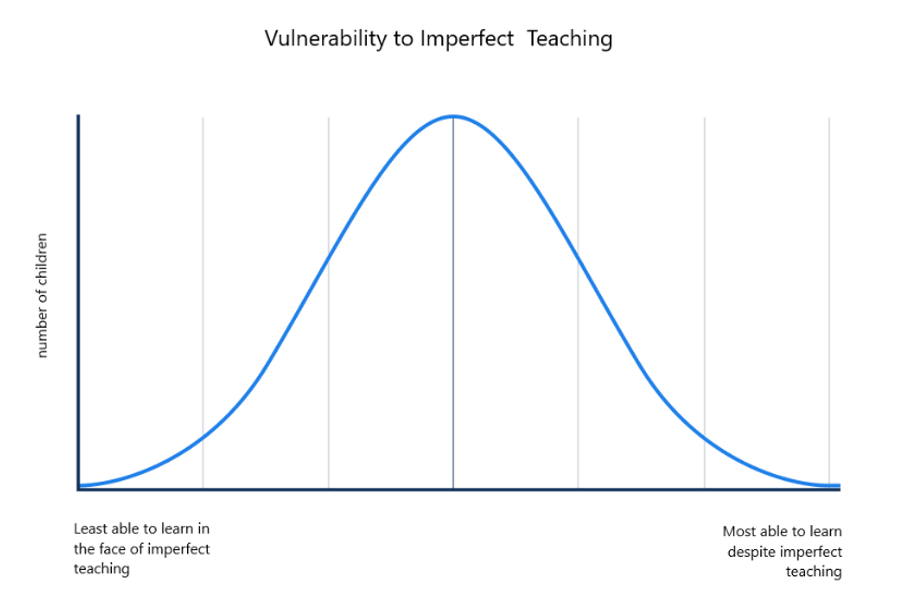
We can work to make our teaching less imperfect by
- Reducing memory demands (and thus reducing the number of things learners have to think about at the same time)
- Anticipating memory demands (by having a curriculum that is sequenced to reinforce, connect, prepare and deepen)
- Support memory demands (by scaffolding that ‘holds’ some of the memory demands for the learner, allowing them to think with the same content as everybody else)
- Strengthen memory (through a robust culture of retrieval so knowledge is remembered long term and by ensuring learners know enough to access lessons – which may involve interventions if fundamental building blocks of learning are not in place)
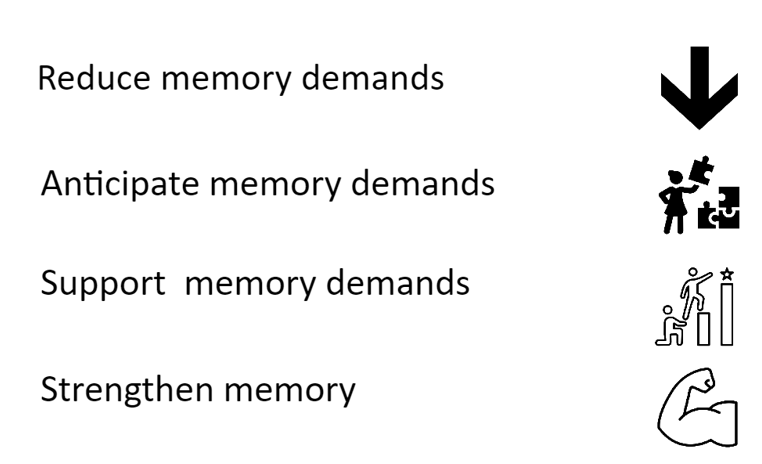
It is important to note that much of this is not just the responsibility of individual teachers and involves school wide systems and culture. Curriculum design that anticipates memory demands, having a clear teaching and learning policy, creating a robust culture of retrieval and running appropriate interventions are whole school decisions. Because adaptive teaching features in the DfE Teaching Standards, I can imagine a tick box, compliance focused performative approach to checking for adaptive teaching where the onus is all on individual teachers. Indeed, I have seen a lesson planning proforma which included a box for adaptive teaching! Yet, to use the familiar iceberg metaphor, observable teaching is one small element of adaptive teaching – there is a whole raft of whole school stuff below the surface, not least training teachers well so that they understand what adaptive teaching means in a way not shot through with lethal mutations.
Reducing memory demands
As mentioned above, this is the approach that underpinned much of traditional differentiation. Some learners were expected to think about fewer things than others. A notorious example of this did the rounds on Twitter a while back when teachers were asked to share an example of the worst feedback they had ever received after a lesson observation. After a lesson on the five pillars of Islam, an RE teacher got the feedback that maybe they should have given the ‘lowers’ just one pillar rather than all five – thus managing to be offensive not only to the learner deemed ‘lower’ but also to Islam!
The place for reducing memory demands in an adaptive teaching approach is not on an individual basis but by thinking about the memory demands we are imposing on all learners, particularly during the explanatory – or “I do” – phase of the lesson. All learners will learn better if we make sure we:
- explain the learning rather than explaining activities
- break learning into small steps
- are explicit – don’t assume learners already know the prerequisite knowledge essential to understand what you are teaching.
- make sure visual information – for example on slides – is clear, legible and uncluttered
- be aware of the transient information effect. Spoken words disappear as soon as uttered – leaving no trace. Information on PowerPoints disappears when the next slide is clicked. We can reduce memory demands by having information written in more permanent form – on flipchart paper or in a booklet on the desk for example
So to return to the five pillars example, thinking about reducing memory demands would involve:
- having really clear, succinct explanations
- chunking explanations so the whole class learn about and then apply their learning one pillar at a time
- ensuring learner understand terms like pillar both literally and metaphorically
- using clear, legible, uncluttered visual information which adds to your spoken explanation without introducing extraneous visual noise
- giving learners more permanent access to this information via written materials
Reducing memory demands can further be considered during the ‘we do’ phase through checking for understanding and reteaching as necessary. Even with our explanation broken down into small steps, clear visuals and mitigations for transience, there may well be some learners for whom this was still too much too soon. We need to be aware of who needs further explanation and practice. We need to repeat until everyone is enabled to be successful. The “I do>we do> you” do sequence may more helpfully be thought of as the “I do> we do>we do>we do> we do> we do > we do> you do” sequence, because adaptive teaching involves adapting teaching in real time, flexing in the moment in the light of information we are gathering in the course of the lesson. Finally, in the “you do” phase of the lesson, we need to ensure we give everyone sufficient time for practice and avoid giving memory-intensive, open-ended tasks too early. There is a time for problem solving, but that comes once the material necessary for solving problems is secure in long term memory. The amount of time allocated to practice should be thought about and planned for in advance, rather than a consequence of whatever time happens to be left in a particular lesson.[3]
There may be a very small minority of learners whose needs as such that they do need to think about fewer things than their peers. For example, a child with a moderate learning difficulty might learn about the five pillars without encountering the Arabic terms for them and in narrative rather than explanatory form. Where learning needs lie beyond what adaptive teaching can achieve, differentiation by task is appropriate.
Anticipating memory demands
We can anticipate memory demands by having a coherently sequenced curriculum that deliberately crafts readiness for more abstract content. The curriculum should reinforce and build on previous knowledge: connecting new learning to previously learned content, deepening understanding of concepts as they are revisited in different contexts. As well as looking backwards, the curriculum should prepare for and improve access to future learning. Anticipating future memory demands is the ultimate adaptive teaching hack. Seemingly abstract concepts become less abstract through familiarity and when the prior curriculum deliberately and explicitly teaches learners enabling knowledge. The responsibility for this does not divide neatly into primary and secondary school blocks. Primary schools have a responsibility to craft readiness for the secondary curriculum and secondary schools have a responsibility to make connections with and build on the primary curriculum.
If we want learners to understand deposition and transportation of materials in rivers in key stage three, then they need to have learnt about erosion within key stage two and before that, about rocks and soils. Hands on experiences in the Early Years playing with mud, sand and water prepare learners to understand in abstraction what they have encountered first hand.
If we want learners to understand the reproductive cycle of flowering plants in key stage three, then they need to have learnt about – and this includes practical experience of – the germination of a range of plants in primary school. Not just once, by growing a bean, but experiencing and talking about the process of germination in seeds and bulbs. What changes over the course of the primary years is the expectations around use of technical language and ability to generalise across different plants.
If we want learners to be able to understand a variety of different musical scales in key stage three – major, minor, chromatic, blues and world music scales for example, then they need to have learnt about and performed music of different pitch in key stage one, laying the ground for learning about pentatonic melody in lower key stage two before learning about octaves in upper key stage two.
You may of course quibble about what I am putting where – but the point is, if we want learners to build progressively more complex schema and to grasp abstract ideas with confidence, then we need to lay the appropriate foundations through coherent, well sequenced curriculum design. Obviously creating such a curriculum is a whole school undertaking and not the responsibility of individual teachers. The responsibility of individual teachers lies in knowing what comes before and after rather than just knowing the curriculum for the year groups they are teaching, so that they can build on or revisit previous learning and also prepare for subsequent learning. Giving teachers time to do this would be very effective CPD.
Supporting memory demands
We can support memory demands through using scaffolding to ‘hold’ some of the memory demands for the learner. The term ‘scaffolding’ is bandied about as the go to strategy for adaptive teaching, without really making it clear how it actually enables learners with cognitive challenges to access learning. The difference between reducing memory demands and supporting memory demands is that when we reduce memory demands, we deliberately plan to teach less initially, by breaking things up into small steps as a strategy to manage cognitive load. This can then lead to more being learnt eventually. When we support memory demands, everybody has the same opportunities to apply knowledge. Scaffolding provides ways of supporting memory demands so that the learner doesn’t have to hold too much in mind all at once but can still think in sophisticated ways. There should always be a plan to reduce scaffolding over time. This may involve strengthening memory which we will visit in the next section.
Ten strategies to support memory
These strategies learn heavily on Andrew Percival’s 12 Teaching Tools. During a learning sequence, several of these strategies may used, but always with the aim of independence with scaffolding being withdrawn as learners become more confident and successful.
- Matching
Matching supports learning because learners only have to think about the links between items – not remember the things themselves. This can be used with quite sophisticated material. The first two examples are taken from Juli Ryzop of the Primary Knowledge Curriculum Trust.

Here the learner matches the main clause with the correct subordinate clause. Neither clause needs to be held in memory (yet), so working memory is freed up to consider which main clause matches with which subordinate clause.

In this more challenging example, there are three items to be matched. Memory is supported both in terms of factual information, and in how to construct a complex sentence.
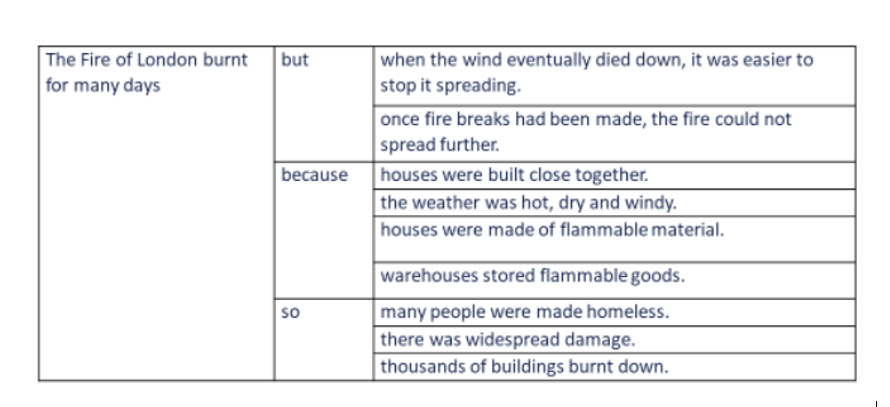
This example borrows the sentence builder strategy familiar to MFL colleagues. The learner has choice about which sentences to match with the stem sentence and conjunction. The learner is supported to think about nine different aspects of the Fire of London and how to write a complex sentence. This scaffolding could be faded out over the course of a few lessons by gradually blanking out either the conjunction, or the second part of the sentence (or part of the second part).
- Sorting
- Learnerren only have to think about the properties – not remember the things themselves.
Sorting supports memory demands because learners only have to think about properties, and not the things themselves which are held in memory for them. This can be used to sort information into examples and non-examples, or to sort into categories or sequences by time.
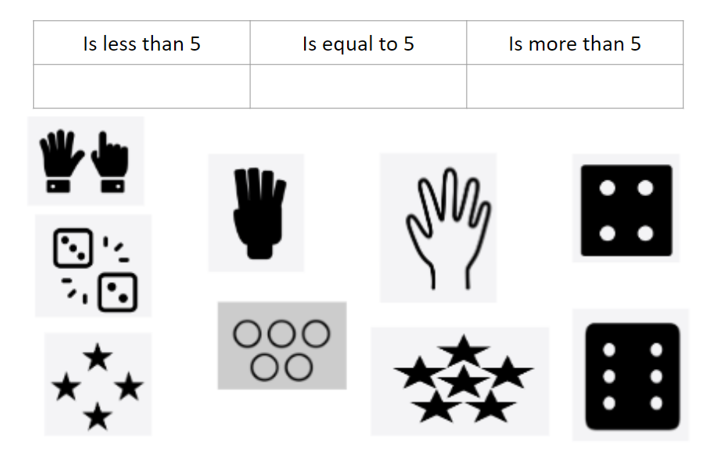
In this example, memory is supported because learners do not have to count out quantities, possibly losing place or dropping equipment. These are given through a pictorial image which further supports memory by enabling subitising rather than counting. All the learner needs to think about is deciding whether a representation is more, less or equal to five. Once this is done, of course a learner could make or draw their own examples.
Here’s an example from the science curriculum:
| Mammals | Not mammals |
Tiger
Snail
Seagull
Cat
Elephant
Worm
Mouse
Goldfish
Human
Whale
Crab
Here memory is supported as the learner does not need to think about how many different sorts of animals they know – which are likely to mainly be mammals anyway – but instead can think about whether or not each given example is or is not a mammal – focusing finite mental resources on categorisation not how many animals they know. Again, once this is done, some learners will be able to challenge themselves to add in further examples that they have come up with independently.
Sequencing events or processes are other examples of scaffolding via sorting.
- Graphic organisers
Graphic organisers support memory by holding the categories into which information is sorted for the learner so learners only need to think about where the information goes and not how to categorise it as well. In fact, graphic organisers are really just sorting done better – the tables in the two examples above are in fact graphic organisers themselves. Oliver Caviglioli in Organise Ideas explains how ideas can be categorised as being either ‘container’ or ‘path’. Container is where we sort ideas either by chunking into categories or by comparing them. Path is where we sequence ideas or think about causes, effects and consequences. Oliver has generously shared many resources such as the Dual Coding to Organise Ideas PowerPoint here – though I strongly recommend buying his book.
Particularly useful ‘comparison’ examples are the target map and the Venn diagram.
These target map examples are thanks to Karl McGrath Curriculum Task Design Lead at Benton Park Primary and all the teachers there who have provided examples. See the Primary Task Design Facebook group for more ideas of how to use this model.
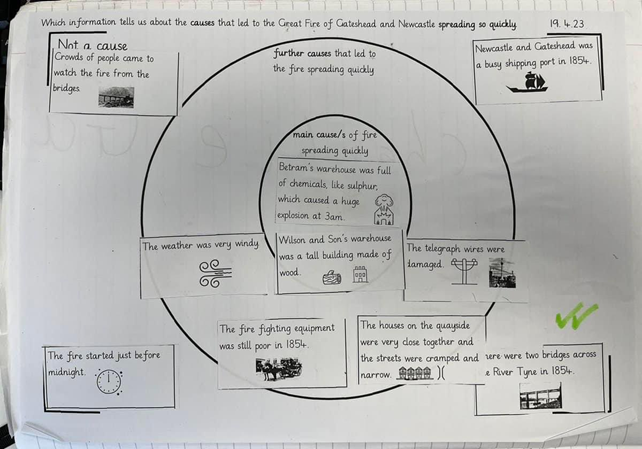
In this example, we can see how the target model has scaffolded the longer piece of writing.
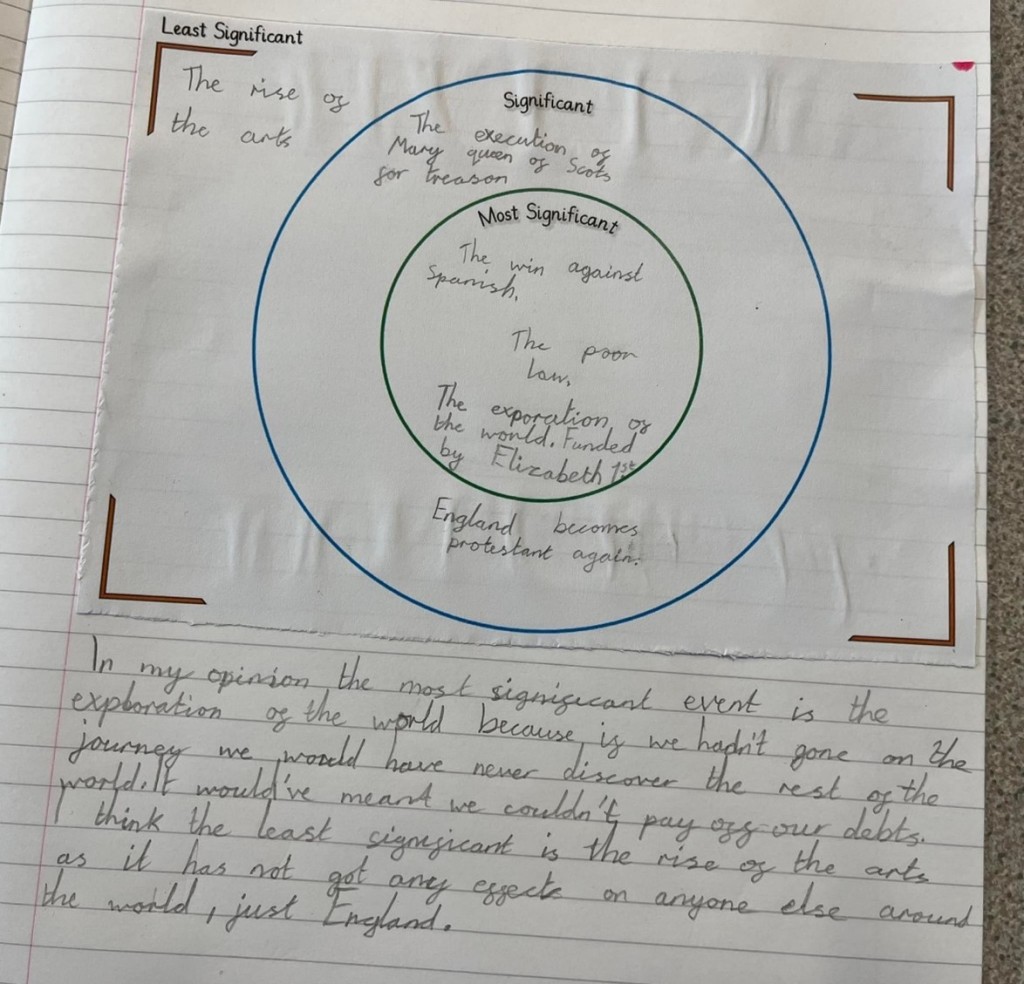
And here we can see how it has been used in maths
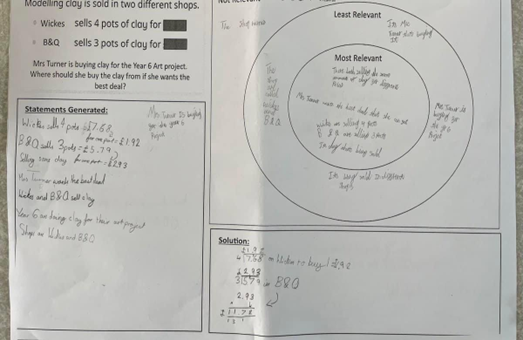
Venn diagrams are used in this example to organise information into aspects that are the same and aspects that are different about dark and light speckled moths, having read this text.

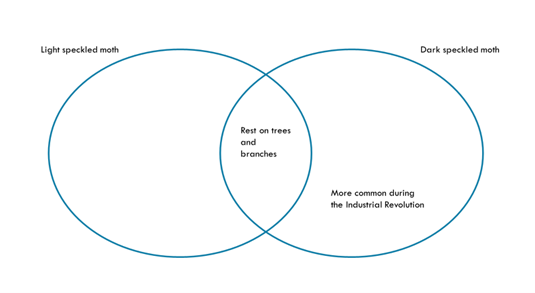
Different levels of scaffolding can be provided with more or less text given up front.
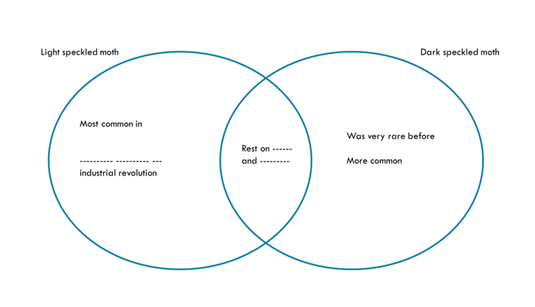
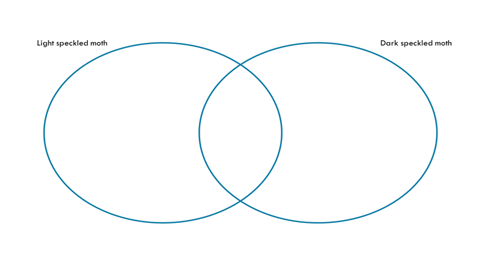
- Word banks
Giving information in word banks prior to asking learners to write an explanation holds the memory demands of the information so that the learner can think about crafting sentences, spelling and handwriting.
What characteristics do mammals have?
- Fur or hair or blubber
- Breathes with lungs
- Gives birth to live young
- Makes own heat
In this next example, a graphic organiser – a simple table- is combined with a word bank for some more complex sorting.
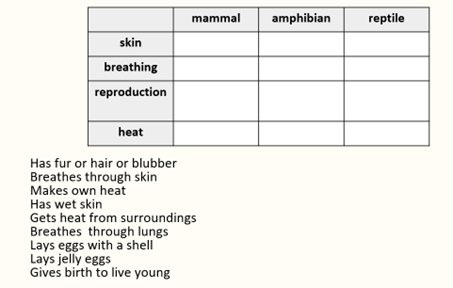
- Sentence starters
Providing sentence starters holds the memory demands of both aspects of the story or information and/or different sentence types.
Red Riding Hood wore…
She carried …
Her mother warned her …
Her grandmother needed food so…
Because of the dangerous wolf, …
Similarly as a scaffold to write about the water cycle:
Heat from the Sun causes water to …
Evaporation occurs when liquid water …
Warm water vapour rises up through …
As the water vapour rises higher and higher, the cool air of the atmosphere …
This process is called …
When a cloud becomes full of liquid water, it …
Rain and snow then fill …
The process then…
As part of gradually withdrawing scaffolding, in a subsequent lesson the activity could be repeated with lighter scaffolding, then finally withdrawn altogether.
Heat from the Sun…
Evaporation …
Warm water vapour …
As the water vapour rises …
When a cloud …
Rain and snow …
The process …
For writers at the very earliest stages of learning to use phonics in writing, a strategy called Russian scaffolding can be used. I have no idea why it is described as Russian!
- Fix the error
In fix the error, text or a calculation with (or possibly without) an error has to be thought about and errors identified and rectified. Here the learner’s working memory is focused on reasoning and sense making rather than generating or remembering content.
The Great Fire of London many days.
One reason was that houses was very flammable.
Another reason was that the weather hot dry.
The strong wind the flames from house to house
Or
6=2+3
5=3+4
6=2+4
Here’s a science example, revisiting a graphic organiser from earlier.
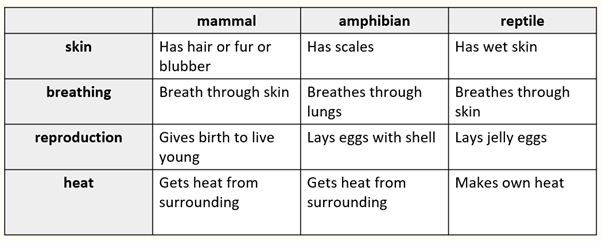
- Sentence jumbles
Like fix the error, jumbled up sentences ask the learner to deploy working memory to think about sense rather than generating content.
days of The London burnt many Great for Fire
have Reptiles skin scaly snakes as such
- Complete the fragment
As in the two previous examples, the focus here is on sense making though with learners also having to transform the fragment into a sentence.
burnt for many days
were very flammable
was hot and dry
The wind cause the flames to
- Sentence combining
Learners are given two sentences which they then try to combine by using appropriate conjunctions. Here memory is again focusing on sense making rather than generating content, which is held for the learner.
The Fire of London burnt for many days. Once fire breaks had been made it could not spread any further
The Fire of London burnt for many days. The weather had been hot and dry for a very long time.
The Fire of London burnt for many days. Many people lost their houses and became homeless.
- Bringing it all together through chunking
Once learners have experienced success in learning content and making sense of it, they are then ready to bring what they have learned together in a longer piece. Here scaffolding holds the memory demands of how to organise a longer piece of writing so learners can think about what they now know and how they can craft clear sentences to communicate their knowledge.
For example, see this from @MRMICT (also from Benton Park Primary and admin for the Primary Task Design Facebook group and the person who generously shared this and the above images with me).
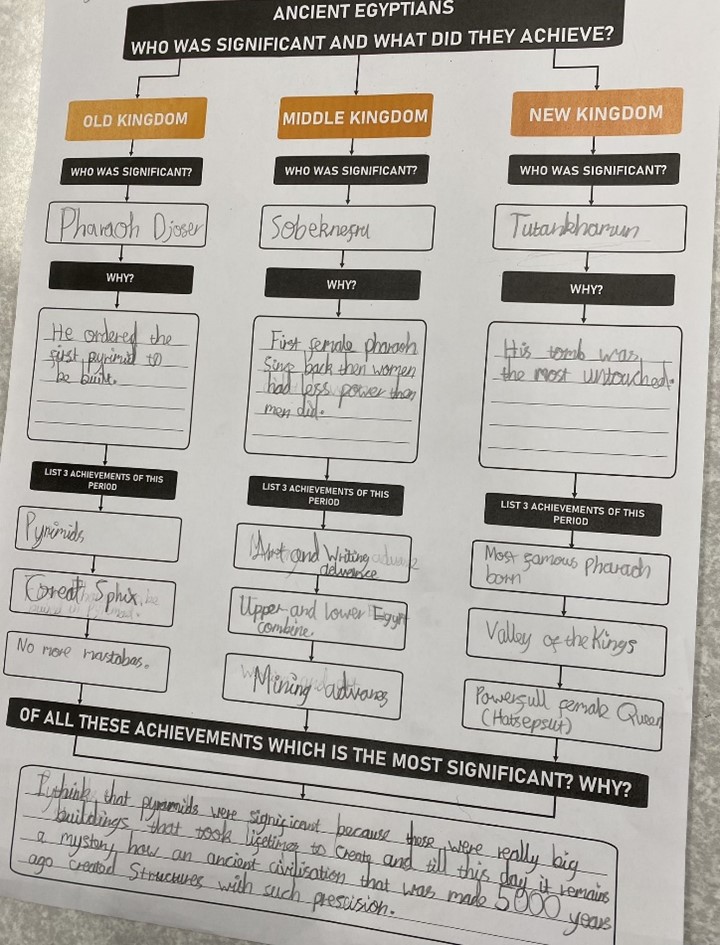
Or this example from @MRA_RQT (apologies for cutting off the right hand side of the image).
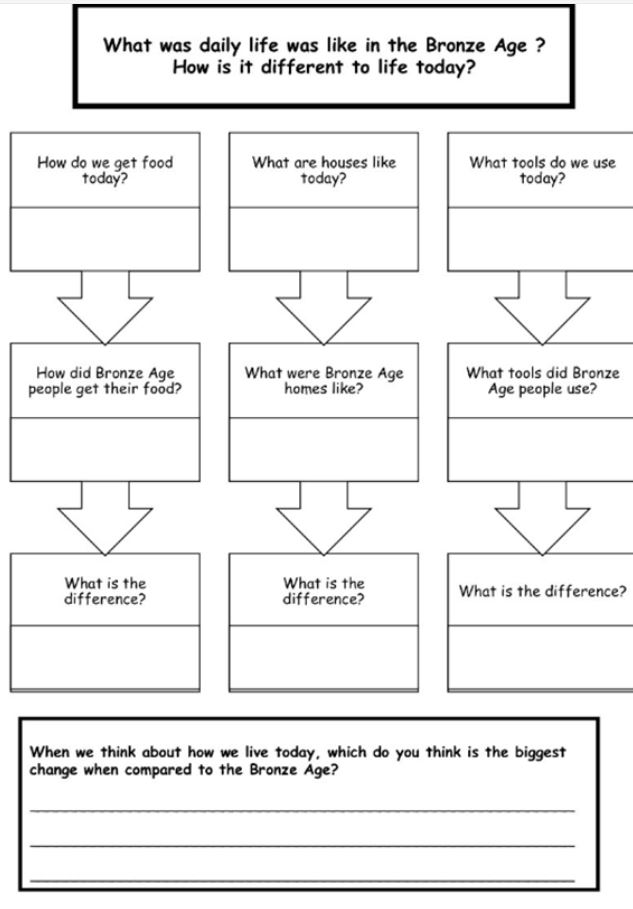
Structure strips are another way of holding the memory demands of text organisation for the learner, freeing them up to think about content.
Strengthening memory demands
There are two aspects to strengthening memory, a general aspect of benefit to all learners and a specific aspect vital for learners who do have not yet acquired the pre-requisites upon which all subsequent learning depends, for example phonics, number bonds, handwriting, aspects of speaking and listening.[4]
The general aspect arises because forgetting is not, as we might imagine, an annoying hindrance to learning. Forgetting is, as counter-intuitive as it may seem, as Carl Hendrick explains brilliantly here, an integral part of the learning process. We may have an episodic mental model of learning whereby lessons teach objectives that are then remembered (or not). However learning does not happen in this linear fashion, lesson by lesson, keeping pace with coverage. It’s much messier than that. Material is encountered, forgotten (which is really about it being lost rather than disappearing) refound – or as we all call it, retrieved (from the French retrouver to refind). The reason why retrieval practice is important is because the very act of refinding the information forms new and possibly more useful associations between the thing remembered and relevant cues.
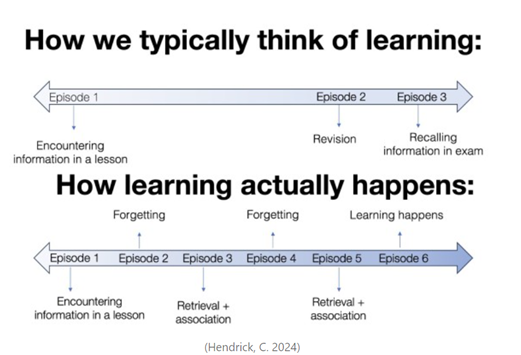
As Henrick puts it, ‘You don’t learn something when you encounter it, you learn it when you forget it-remember it-forget it -remember-link it to something else you know and so on… Think of learning as something which happens over 6-12 months not in a single lesson.’
Strengthening learning therefore needs a strategic approach that plans for forgetting and builds in retrieval opportunities. This is useful for all but absolutely vital to learners with smaller working memories who can compensate for this by having a well-stocked and well organised long-term memory. Effective organisation of long-term memory is the result of both deliberate curriculum design that anticipates forgetting and future association and also through planned opportunities to refind – retrieve – previously forgotten content in contexts likely to forge helpful associations.
The more specific aspect concerns the learning of key prerequisites such as phonics or number bonds to the point of automaticity. Once something is known to automaticity, it takes up very little room in working memory. This frees up the brain to engage in more complex forms of thinking. Automaticity is a gateway to being able to think critically. It is therefore imperative that all learners – and in particular learners with smaller working memories – are given the practice time needed to acquire automaticity. For learners with smaller working memories, the acquisition of automaticity may take longer and need more practice, often through what we call interventions. There is however a tension here – the more we take learners out of class for interventions (or outerventions as I’ve heard them called in parody) the more we deprive them of learning the same as their peers, potentially widening the gaps rather than reducing them – in effect reducing their curriculum. Such decisions are weighty ones, not to be made lightly and certainly not as a strategy of first resort. Ideally this extra practice time is led by a teacher and while the rest of the class are also practising something – independent reading for example – rather than learning something new.
Traditional differentiation – at least in its mutated form – tended to fatalism about the learning potential of a sizable proportion of each class. Some learners did not know enough to access the content that most of the class were learning so therefore needed easier – reduced – content. That was just how things were. An adaptive teaching approach on the other hand believes reducing the level of challenge should be rare rather than routine. Before we make the serious decision to limit what we teach a particular learner, we should be really sure that the other levers open to us – a curriculum that anticipates, teaching strategies that support and strengthen memory – are either being effectively deployed or cannot possibly overcome the barrier to learning that a specific learner faces. These kind of far-reaching decisions should not be left to individual teachers but at the very least should involve SENDCos and possibly other professionals too.
[1] I’ve thought long and hard about whether to use the term learner, child, pupil or student. This blog is meant to apply regardless of phase. Learner is the most generic, so I’ve somewhat reluctantly chosen that.
[2] Peps McCrea explains upstream and downstream well here. (1) Peps on X: “The best teachers and leaders tend to think ‘upstream’. What do I mean by that? Here’s what you need to know: ↓” / X (twitter.com)
[3] From Ofsted maths subject report. ‘Pupil practice is sometimes limited in quality and quantity in both primary and secondary schools. This happens when leaders see practice as an activity, rather than focusing on its outcomes – whether pupils have practised until they have learned, to automaticity, the intended mathematical knowledge. There is often no consensus among leaders about benchmarks for optimal quality and quantity of practice that gives assurance that pupils have learned what is intended.
[4] As mentioned previously, in this blog I am only talking about the cognitive aspects of learning. Clearly there are also physical, communicative and personal, social and emotional aspects that may also strengthening or supporting and should be anticipated and at times, reduced. Handwriting for example, is dependent on physical strength and flexibility.
Wonderful blog Clare, so much to unpack. I’ll share this on my Facebook page. Thank you for your generosity in sharing it.
LikeLike
Thank you.
LikeLike